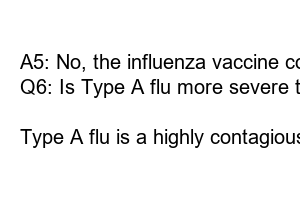A형독감
Title: Unmasking Type A Flu: Symptoms, Prevention, and Treatment
Introduction:
Welcome to our comprehensive guide on Type A flu! With flu season upon us, it is crucial to understand this contagious respiratory illness that affects millions of people worldwide. In this blog post, we will delve into the symptoms, prevention measures, treatment options, and frequently asked questions about Type A flu. Let’s get started!
1. What is Type A Flu?
Type A flu is a highly contagious virus that primarily affects the respiratory system. It spreads through droplets released when an infected person coughs, sneezes, or talks. A person can become infected by inhaling these droplets or by touching a surface contaminated with the virus.
2. Symptoms of Type A Flu:
Type A flu can cause a range of symptoms, including **high fever**, cough, sore throat, body aches, fatigue, chills, runny or stuffy nose, headaches, and sometimes vomiting and diarrhea. These symptoms often occur suddenly, making it important to prioritize prevention and early treatment.
3. Prevention Measures:
Prevention is key in avoiding the spread of Type A flu. The following measures can help reduce the risk of contracting and transmitting the virus: **regular handwashing**, using hand sanitizers, avoiding close contact with sick individuals, covering your mouth and nose when coughing or sneezing, and getting an annual flu vaccine.
4. Treatment Options:
If you suspect you have Type A flu, it is essential to seek medical attention promptly. **Antiviral medications** can help alleviate symptoms and reduce the severity of the illness if taken within the first 48 hours of symptom onset. Rest, staying hydrated, and over-the-counter medications to ease discomfort can also provide relief.
5. Who is at Risk?
While anyone can contract Type A flu, certain groups face a higher risk of severe symptoms and complications. **Young children**, older adults, pregnant women, individuals with underlying health conditions, and those with weakened immune systems need to take extra precautions.
6. FAQs about Type A Flu:
Q1: How long does Type A flu last?
A1: The illness typically lasts for about a week, but recovery may take longer depending on an individual’s overall health.
Q2: Can the flu vaccine prevent Type A flu?
A2: Yes, the annual flu vaccine can help protect against Type A flu, as well as other strains of the influenza virus.
Q3: How effective is handwashing in preventing Type A flu?
A3: Proper handwashing for at least 20 seconds with soap and water is one of the most effective ways to prevent the spread of the virus.
Q4: When should I seek medical attention?
A4: If you experience severe symptoms, persistent fever, difficulty breathing, or if symptoms worsen over time, it is crucial to seek medical care promptly.
Q5: Can I get the flu from the vaccine?
A5: No, the influenza vaccine contains inactivated viruses or only a piece of the virus, making it impossible to contract the flu from the vaccine.
Q6: Is Type A flu more severe than Type B flu?
A6: Both types of flu viruses can cause severe illness, but Type A flu tends to cause larger outbreaks and has a higher potential for complications.
Summary:
Type A flu is a highly contagious respiratory illness that can cause a wide range of symptoms, including high fever, cough, sore throat, and body aches. Prevention measures like regular handwashing, avoiding close contact with sick individuals, and getting an annual flu vaccine are crucial in reducing the risk of contracting and transmitting the virus. Prompt medical attention, rest, and antiviral medications can help alleviate symptoms and shorten the duration of Type A flu. Remember, early recognition and preventive measures go a long way in keeping yourself and those around you healthy during flu season. Stay informed, stay protected!

